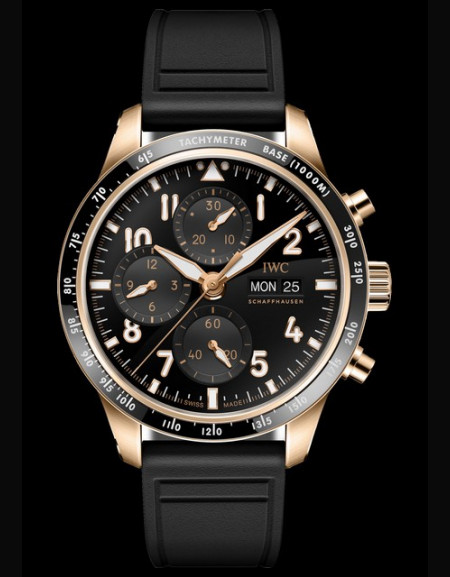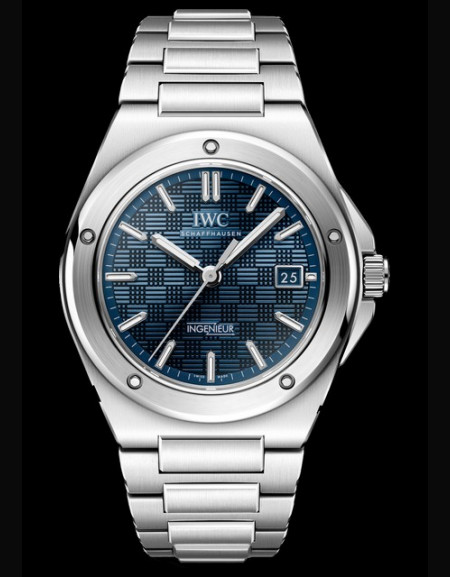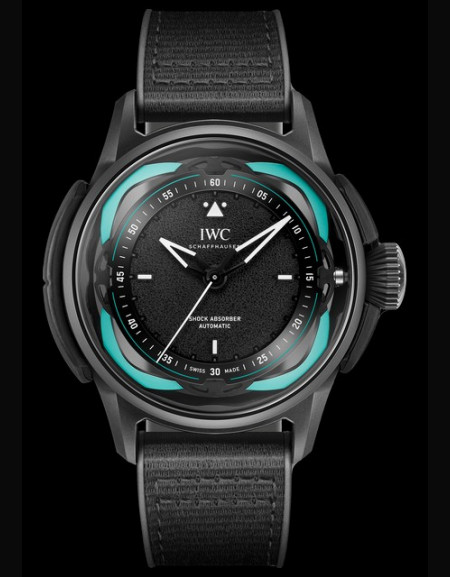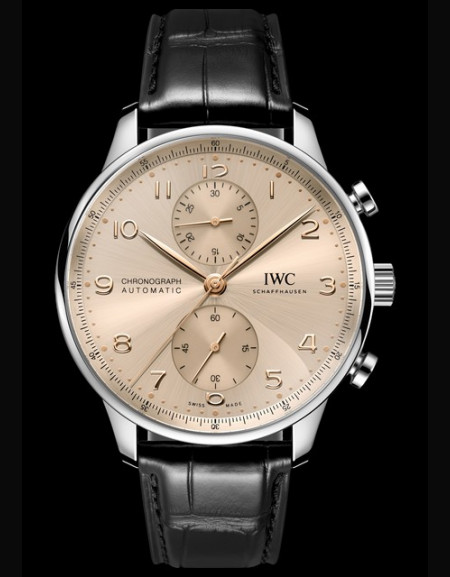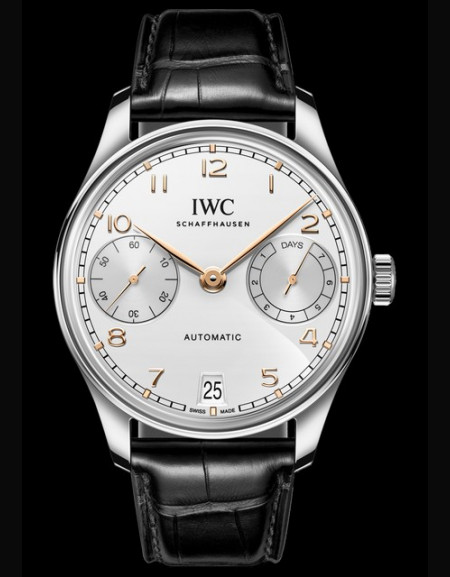
|
||
History of IWC Schaffhausen
It all started more than 140 years ago in Boston where the talented and enterprising watchmaker Florentine Ariosto Jones was looking for an opportunity to set up on his own and do things much differently and better than his colleagues
in the flourishing American watch industry. As the director of F. Howard Watch & Cie at that time, he had of course heard of the little country of Switzerland and its outstanding watchmakers.
He was fired up by the information that workers in the Swiss watch industry produced their w...

THE COLLECTIONS

-
Pilot’s Watch Performance...
SEE THE DATA SHEETBrand: IWC
Collection: Pilot's Watches
Ref: IW388801
Price: 90 100 € -
Pilot’s Watch Chronograph...
SEE THE DATA SHEETBrand: IWC
Collection: Pilot's Watches
Ref: IW388116
Price: 7 700 € -
Pilot’s Watch Chronograph...
SEE THE DATA SHEETBrand: IWC
Collection: Pilot's Watches
Ref: IW378009
Price: 7 800 € -
Pilot’s Watch Performance...
SEE THE DATA SHEETBrand: IWC
Collection: Pilot's Watches
Ref: IW388309
Price: 28 900 € -
Big Pilot’s Watch Shock...
SEE THE DATA SHEETBrand: IWC
Collection: Pilot's Watches
Ref: IW357701
Price: ON REQUEST -
Ingenieur Perpetual...
SEE THE DATA SHEETBrand: IWC
Collection: Ingenieur
Ref: IW344903
Price: 40 200 € -
Ingenieur Automatic 42
SEE THE DATA SHEETBrand: IWC
Collection: Ingenieur
Ref: IW338903
Price: 21 200 € -
Ingenieur Automatic 40
SEE THE DATA SHEETBrand: IWC
Collection: Ingenieur
Ref: IW328908
Price: 14 000 € -
Ingenieur Automatic 40
SEE THE DATA SHEETBrand: IWC
Collection: Ingenieur
Ref: IW328702
Price: 50 600 € -
Ingenieur Automatic 35
SEE THE DATA SHEETBrand: IWC
Collection: Ingenieur
Ref: IW324906
Price: 11 100 € -
Ingenieur Automatic 35
SEE THE DATA SHEETBrand: IWC
Collection: Ingenieur
Ref: IW324901
Price: 11 100 € -
Ingenieur Automatic 35
SEE THE DATA SHEETBrand: IWC
Collection: Ingenieur
Ref: IW324903
Price: 41 000 € -
Ingenieur Automatic 40
SEE THE DATA SHEETBrand: IWC
Collection: Ingenieur
Ref: IW328907
Price: 12 700 € -
Big Pilot’s Watch Shock...
SEE THE DATA SHEETBrand: IWC
Collection: Pilot's Watches
Ref: IW356201
Price: ON REQUEST -
Pilot’s Watch Mark XX...
SEE THE DATA SHEETBrand: IWC
Collection: Pilot's Watches
Ref: IW328210
Price: 6 600 € -
Ingenieur Automatic 40
SEE THE DATA SHEETBrand: IWC
Collection: Ingenieur
Ref: IW328907
Price: 12 700 € -
IWC Portugieser Perpetual...
SEE THE DATA SHEETBrand: IWC
Collection: Portuguese
Ref: IW503701
Price: 49 500 € -
IWC Portugieser Perpetual...
SEE THE DATA SHEETBrand: IWC
Collection: Portuguese
Ref: IW503702
Price: 49 500 € -
IWC Portugieser Perpetual...
SEE THE DATA SHEETBrand: IWC
Collection: Portuguese
Ref: IW503704
Price: 50 500 € -
IWC Portugieser Perpetual...
SEE THE DATA SHEETBrand: IWC
Collection: Portuguese
Ref: IW503703
Price: 50 500 € -
IWC Portugieser...
SEE THE DATA SHEETBrand: IWC
Collection: Portuguese
Ref: IW545901
Price: 86 000 € -
IWC Portugieser Eternal...
SEE THE DATA SHEETBrand: IWC
Collection: Portuguese
Ref: IW505701
Price: ON REQUEST -
Portugieser Chronographe
SEE THE DATA SHEETBrand: IWC
Collection: Portuguese
Ref: IW371624
Price: 8 950 € -
IWC Portugieser Chronographe
SEE THE DATA SHEETBrand: IWC
Collection: Portuguese
Ref: IW371625
Price: 19 900 € -
Portugieser Chronographe
SEE THE DATA SHEETBrand: IWC
Collection: Portuguese
Ref: IW371626
Price: 21 000 € -
Portugieser Automatic 40
SEE THE DATA SHEETBrand: IWC
Collection: Portuguese
Ref: IW358401
Price: 19 000 € -
Portugieser Automatic 40
SEE THE DATA SHEETBrand: IWC
Collection: Portuguese
Ref: IW358402
Price: 20 000 € -
Portugieser Automatic 42
SEE THE DATA SHEETBrand: IWC
Collection: Portuguese
Ref: IW501704
Price: 15 000 € -
Portugieser Automatic 42
SEE THE DATA SHEETBrand: IWC
Collection: Portuguese
Ref: IW501702
Price: 14 000 € -
Portugieser Automatic 42
SEE THE DATA SHEETBrand: IWC
Collection: Portuguese
Ref: IW501701
Price: 14 000 € -
Portugieser Automatic 42
SEE THE DATA SHEETBrand: IWC
Collection: Portuguese
Ref: IW501705
Price: 14 000 € -
Portugieser Automatic 42
SEE THE DATA SHEETBrand: IWC
Collection: Portuguese
Ref: IW501707
Price: 27 000 €
History of IWC Schaffhausen
It all started more than 140 years ago in Boston where the talented and enterprising watchmaker Florentine Ariosto Jones was looking for an opportunity to set up on his own and do things much differently and better than his colleagues
in the flourishing American watch industry. As the director of F. Howard Watch & Cie at that time, he had of course heard of the little country of Switzerland and its outstanding watchmakers.
He was fired up by the information that workers in the Swiss watch industry produced their watches for amazingly low wages and in the main with old machines. Wages in Switzerland were then still really low, something that may seem surprising today. And so a compelling business idea came to F. A. Jones: Why not manufacture quality watches in Switzerland under more favourable conditions, but with new and better machines, for the North American market ?
His idea was conceived, planned and carried out: in New York Jones set up a sales organization with two business partners where pocket watch movements manufactured in Switzerland were to be put in cases and then sold throughout North America. The company was given a grandsounding name: International Watch Company.
Jones set off by boat to Europe with his watchmaker friend Louis Kidder. Along with a whole host of ideas, the two men also took with them machines for the mass production of parts and finished design drawings for the first Swissmanufactured watches.
Initial surprise: in the watchmaking centres of western Switzerland where Jones had intended setting up his business the innovator was given the cold shoulder. The locals, who mainly produced watch parts in their homes, feared the modern machines and the concept of mass production even if it did have the indisputable advantage of consistent quality.
This is where the story could have ended. But in western Switzerland Jones met Heinrich Moser, a versatile industrialist from Schaffhausen. He made the American an offer that was tempting even if not completely altruistic: he could start immediately in Schaffhausen, a small town in northern Switzerland the American had certainly never heard of until then - in industrial buildings Moser owned. What persuaded him was that a source of energy was already available there for the machines - electricity was not even a consideration then. A hydrostation built by Moser brought the power required for the machines directly into the factory using shafts and long transmission cables. So in 1868 Jones arrived in Schaffhausen - and Schaffhausen, a long way from western Switzerland, got a watch factory.
Jones was, therefore, able to realize his bold ideas. Even his principle of manufacturing highquality watches with consistent tolerances worked - and this was the beginning of the reputation now enjoyed by Schaffhausen watches throughout the world.
Six legends celebrate 140 years of IWC Schaffhausen
IWC Vintage Collection - Jubilee Edition 1868-2008
What had been a promising start in watchmaking with the first "Jones calibres", named after the company's founder, ended in difficulties commercially for Jones when America did not lower the 25 per cent war duty imposed in 1864 - contrary to what was announced. The advantage of lower Swiss wages vanished. Jones returned to Boston and the "American watch factory" passed into Swiss hands. However, the founder did leave behind his particular aspiration for sophisticated, ever-better technical solutions.
Despite the initial difficulties the manufacturer became one of the most renowned producers of sturdy and durable pocket watches.
And it was there right from the start at the turning point in watchmaking history when the wristwatch came into favour around 1900. The battle about how to wear a watch was decided for good by the 1930s and 1940s. The onset of this period of technical innovation brought some of the most exciting IWC watches, still much sought-after by collectors today. Some of them even wrote watch history.
Six watches - six founding legends of today's IWC watch families
Six of these milestones have been brought back as vintage models from the company's proud history into the modern day for the manufacturer's 140th anniversary in 2008 - even if it is not a "round" one. Not as copies, something that IWC has never done, but as new interpretations of good old friends. Some with ultra-modern, up-to-date automatic IWC movements, which are also used in the current collection. In other cases, where historical accuracy demands, they have been equipped with hand-wound pocket watch movements based on the 98-calibre, the most famous IWC calibre and the one that has been produced for the longest, but they have also been expanded, incorporating some of the elements of the earliest Jones movements.
And, to the extent that their predecessors had not already appeared in the IWC extra-large format, the case of some of the models in the current Vintage Collection has increased in size on its journey through time, which on first sight makes them distinguishable from the originals. But in this way they have also taken on completely new watch personalities. They illustrate how, for example, a 1955 Ingenieur would have looked if its case had had a 42.5 mm diameter rather than 37.5 mm.
The six watches, which are available in unlimited numbers in stainless steel with a black dial and in limited numbers in platinum with a silverplated dial, are more than just a "Best of" the wristwatch era at IWC. Each one of them essentially embodies the founding legends of the manufacturer's current watch families. The first 140 vintage watches in platinum have, though, in a way already been reserved: as a special offer they are available as a unique numbered set in an ornate leather case.
Pilot's Watch Hand-Wound
The first Pilot's Watch of 1936 starts things off. As the first special watch for the still young, gruelling form of transport it already had almost all the important features on board: for example a black dial with strong, luminescent hands and numerals that was the model for the development of the classical cockpit design, and later sometimes also a movement with antimagnetic parts of the escapement. And the first of a long a rotating ring with a luminous triangle which helped with roughly calculating the flight time and thus fuel consumption. The modern interpretation of this mother of all IWC pilot's watches has the dial of the original, increased in size to that of the 44mm case, a small seconds hand and a bidirectional adjustable rotating ring with the luminous triangle fitted from the inside. Instead of the 83-calibre, which was used in 1936, the Pilot's Watch Hand-Wound is equipped with a special watchmaking gem - the 98300-calibre: a hand-wound pocket watch movement, a balance frequency of 2.5Hz, large screw balance and Breguet balance spring. The 98-calibre family, the design of which dates from the 1930s, is one of the IWC watch movements that has been series-produced over the longest time. Where it is used in the vintage watches, based on the technical style of the first Jones calibres of 1868 it has the nickel-plated and decorative three-quarter plate made from nickel silver and the elongated index for easier precision adjustment of the active length of the balance spring, which was characteristic of all Jones calibres. The founder has thus left his mark here, something that will naturally catch the eye. For it is not only the actual "window" to the dial that is made of sapphire glass but also the transparent back cover. In addition, the sapphire glass over the dial is coated.
Portuguese Hand-Wound
The Portuguese of 1939 is a true watch legend. And stylistically comes as close as possible to the perfect ideal of a good watch design. As the first "wristwatch" it established the large size was also the first to break the taboo of wearing a complete pocket-watch movement on one's arm. It was successful, and still is today for IWC. It had established a completely new class of watch. There is no question that, as founder of a splendid family of IWC watches, the Portuguese watch is one of the significant witnesses of the company's proud history. It got its name from the fact that just such a watch was requested by two Portuguese businessmen at the end of the1930s. They wanted a high-precision watch that would embody their proud tradition as a seafaring nation. From the start the "Portuguese", as it was only named years later, with all its features was an unofficial marine chronometer and laid out like a navigational instrument. For the Portuguese Hand-Wound, from the numerous dials used for the original Portuguese the most optically interesting one has been chosen, which has never been used for recent Portuguese watches: Arabic numerals and graduations for the indices alternate, the actual measuring range is separated off at the dial centre by another circle, the minute chapter ring is in the "chemin de fer" - railway - style very popular at the time. The same graphic elements also appear in the seconds display circle. The case (44mm) with its fluted bezel and slightly pulled-down strap lugs is in keeping with the original.
The Vintage Portuguese does differ from the original-and the 1993 anniversary model-in that it has antireflective, crossed out sapphire glass over the dial. It is powered by the 98295-calibre that is almost identical to the Vintage Pilot's Watch movement: hand-wound, a balance frequency of 2.5 Hz, large screw balance, Breguet balance spring, nickel-plated silver three-quarter plate, pearled bridges decorated with Geneva stripes. Here too the elongated index, the so-called "Jones arrow", which goes from the balance cock to the plate, is a reference to the company's founder Florentine Ariosto Jones, who founded the manufactory on the Rhine 140 years ago and got it up and running.
Ingenieur Automatic
The Ingenieur Automatic of 1955: No watch has defined the "technical" profile of IWC quite like the Ingenieur, which was introduced in 1955 and which was the first watch to feature the IWC automatic movement developed by Albert Pellaton. With its pawl-winding system and the spring-mounted rotor, it has remained a benchmark for watch technology at the highest level - while retaining the ultimate degree of toughness. This programmatic watch, which exemplifies the watchmaking engineering of the Schaffhausen manufacturer, launched IWC into the modern era. An icon of a quality consciousness handed down since1868, it has remained in the product range under a number of guises. In 1989, a legendary model, the Ingenieur 500,000 A/m, set a world record with its antimagnetic components for the resistance of a mechanical watch against the most extreme magnetic fields.
Half a century after its first appearance, IWC's watchmaking icon was fundamentally revised. That which more than 50 years ago ensured toughness and reliability in the Ingenieur - first as the 8531and later as the 8541 calibre - today finds its logical evolution in the IWC-manufactured 80110 and 80111 calibre. The Ingenieur Automatic is equipped with this unit, which also drives the "new" Ingenieur, presented in 2005. The vintage watch features a 42.5-millimetre case and one of the most stylish Ingenieur dials - with the point-stroke indices (the luminescent material forms the point) and the dauphine-style hands. This model is today a collector's rarity of the very highest order. The modern homage to this watch monument dispenses with the soft iron case of the original, thus affording an insight into the IWC-manufactured movement. With the antireflective, crossed out sapphire glassover the dial and the screw-in crown, the Vintage Ingenieur is water-resistant to 12 bar.
Aquatimer Automatic
The Aquatimer Automatic of 1967: When IWC first took the plunge with its diver's watches, only a few pioneers such as Jacques-Yves Cousteau or Hans Hass had discovered the beauty but also the vulnerability of the underwater world. But they helped to arouse people's enthusiasm for these last paradises. For case makers in particular, manufacturing reliable watches for use under such extreme pressure conditions represented a challenge because when diving, the health or even the life of a diver depends on correct time management. IWC's answer was the first Aquatimer in1967. This too was the first member in a successful family lineage. And some of its technical features, such as the rotating inner bezel which is operated using a second crown, are today a typical characteristic of all of the current range of diver's watches from Schaffhausen. The Aquatimer Automatic in its 44-millimetre case is of course a diver's watch designed for underwater use, equipped with the pressure barriers and sealing systems of the modern Aquatimer watches - with a screw-in main crown and the self-sealing crown developed at IWC to adjust the rotating bezel, which improves handling owing to the fact that it is not screwed in. The clear dial design corresponds to that of the first generation of Aquatimer watches right down to the details, yet is more readable thanks to its new size. The pressure resistance is tested to12bar. With the 80111-calibre movement, the Vintage Aquatimer is superbly powered - it is the same movement that drives the Ingenieur. And this was ultimately also the case in 1967. The 8541-calibre automatic movement, the toughest of its kind at that time, powered both of these heavy-duty watches, namely the Ingenieur and the Aquatimer. However, unlike the historical model, the Vintage Aquatimer has a see-through back cover.
Da Vinci Automatic
The Da Vinci Automatic of 1969: Some people see in it a design challenge, whilst others regard it as the ultimate expression of the avant-garde. The first watch from IWC to be named after the Renaissance genius proved to be a sensation at its premiere appearance at the trade fair in Basle, and in terms of its movement technology at any rate it heralded a revolution. Equipped with the first series-produced Beta 21 quartz movement, which had been developed jointly by several renowned Swiss watch manufacturers, in1 969/1970 it set new standards at least as regards accuracy. It measured time ten times more precisely than a tested chronometer movement. A relatively large quartz resonator stimulated an electromagnetic vibrator, which via fine ruby pawls drove a wheel with 250 teeth, which rotated faster than once a second. This oscillation transmission still bore some similarity to the then likewise successful tuning-fork watches, although the Beta 21 did not hum as noticeably.
IWC had taken great pains to ensure that the first appearance of the new technology was particularly elegant. Opinions were however divided on this, for the triumphal march of the quartz movements with stepping motors, which were produced cheaply on an industrial scale shortly after that, threatened the existence of the traditional craft of watchmaking. For this reason, in the end IWC decided against the "soulless" quartz, and with the second Da Vinci from 1985 it opted decisively for highly developed mechanical action. But the original watch from 1969, in its striking case with corners and edges, the long stroke markers and the unadorned bar hands, remains a piece of contemporary and design history, now being brought to life again as a vintage edition. A contemporary witness with great recognizability, today it is almost an exemplar of modernity once more. But to equip the Da Vinci Automatic with a quartz movement would have contravened IWC's principles and technical requirements. It too is equipped with the IWC-manufactured 80111-calibre automatic movement, with the tried-and-tested Pellaton winding mechanism.
Portofino Hand-Wound
The Portofino of 1984: The most elegant but also the most unassuming family of watches from IWC, the Portofino - the classic example of understatement - has decidedly stylish origins. Collectors know this: it is the Reference 5251 watch, which was still produced until the end of the1990s, always in small quantities. It was impossible to conceal its direct descent from an elegant Lépine pocket watch produced for decades by IWC. For it was, as regards the case, nothing other than a pocket watch converted for use on the wrist, equipped with narrow strap brackets and a smaller crown, and with a very flat original pocket watch movement (95-calibre). The Portofino family, established in1984, was modelled exactly on its shape, thereby following on in the old tradition of elegant, reliable utility watches from IWC, frequently with a gold case.
It represented the"satisfaction in wearinga small piece of gold on one's arm every day", as it was put on the occasion of its launch. The Portofino Hand-Wound, a dream of a watch with its narrow Roman numerals, small seconds display and, as a counterpart to it, a lunar phase display, does however take this opportunity to correct a "quick fix" used in the1980s. For Reference 5251, as it then was, had a charming flaw in that the movement used normally drove an open Lépine pocket watch. And that means that the winding shaft and small seconds display are located in a direct line, in contrast to the Savonette construction of the movement, where the winding shaft and small seconds display stand at an angle of 90°to one another. However, the ultra-flat 95-calibre for Reference 5251did not exist in the Savonette construction. And so here, the two indications of lunar phase display and seconds display ended up in a horizontal position at "3.00" and "9.00" - which looked interesting, but from the watchmaker's point of view was not quite right. In the Vintage Portofino, this "positioning flaw" is remedied by the choice of the 98800-calibre Savonette movement. And through this, the lunar phase and seconds displays finally end up at their traditional places, at "12.00" and "6.00". The movement based on the 98 "Jones" calibre, with nickel-plated three-quarter plate of nickel silver, screw balance wheel, Breguet spring and elongated index, has undergone another fundamental optimization: the display precision of the lunar phase has been increased considerably compared with Reference 5251,and now deviates from the actual lunar sequence by only one day in122 years. The lunar phase can moreover easily be corrected via the crown. The case size of 46mm corresponds to that of the original. Antireflective, crossed out sapphire glass and sapphire glass back invite you to enjoy this magnificent new example of a typical IWC wrist pocket watch from all sides.



